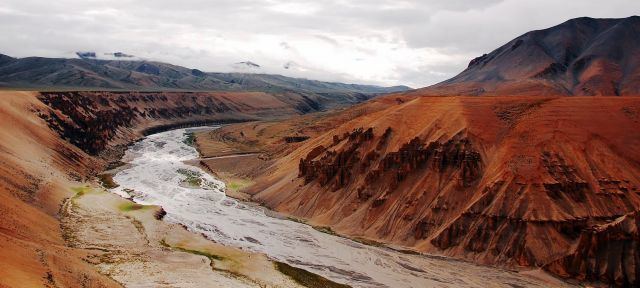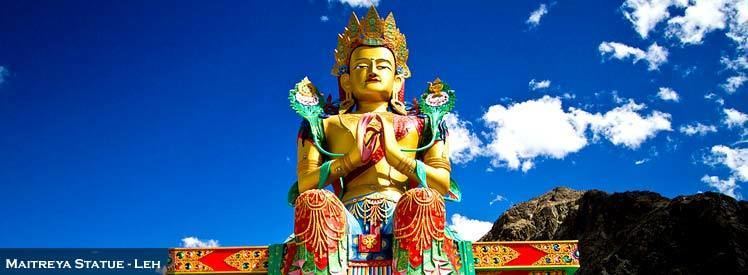Languages spoken English, Ladakhi, Urdu Area 45,110 km2 | State Jammu and Kashmir District Leh | |
Points of interest Namgyal Tsemo Monastery, Magnetic Hill, Nubra Valley, Stok Monastery, Thikse Monastery | ||
Leh (Tibetan alphabet: , Wylie: Gle), was the capital of the Himalayan kingdom of Ladakh, now the Leh district in the Indian state of Jammu and Kashmir. Leh district, with an area of 45,110 km2, is the second largest district in the country, after Kutch, Gujarat (in terms of area). The town is dominated by the ruined Leh Palace, the former mansion of the royal family of Ladakh, built in the same style and about the same time as the Potala Palace-the chief residence of the Dalai Lama until the 14th Dalai Lama fled to Dharamsala, India, during the 1959 Tibetan uprising. Leh is at an altitude of 3524 metres (11,562 ft), and connects via National Highway 1D to Srinagar in the southwest and to Manali in the south via the Leh-Manali Highway. In 2010, Leh was sorely damaged by the sudden floods caused by a cloud burst.
Contents
- Map of Leh
- Journey to ladakh manali to leh road trip
- Leh ladakh with best friends must visit
- History
- Geography
- Agriculture
- Attractions
- Leh cuisine
- References
Map of Leh
Journey to ladakh manali to leh road trip
Leh ladakh with best friends must visit
History
Leh was an important stopover on trade routes along the Indus Valley between Tibet to the east, Kashmir to the west and also between India and China for centuries. The main goods carried were salt, grain, pashm or cashmere wool, charas or cannabis resin from the Tarim Basin, indigo, silk yarn and Banaras brocade.
Although there are a few indications that the Chinese knew of a trade route through Ladakh to India as early as the Kushan period (1st to 3rd centuries CE), and certainly by Tang dynasty, little is actually known of the history of the region before the formation of the kingdom towards the end of the 10th century by the Tibetan prince, Skyid lde nyima gon (or Nyima gon), a grandson of the anti-Buddhist Tibetan king, Langdarma (r. c. 838 to 841). He conquered Western Tibet although his army originally numbered only 300 men. Several towns and castles are said to have been founded by Nyima gon and he apparently ordered the construction of the main sculptures at Shey. "In an inscription he says he had them made for the religious benefit of the Tsanpo (the dynastical name of his father and ancestors), and of all the people of Ngaris (Western Tibet). This shows that already in this generation Langdarmas opposition to Buddhism had disappeared." Shey, just 15 km east of modern Leh, was the ancient seat of the Ladakhi kings.
During the reign of Delegs Namgyal (1660–1685), the Nawab of Kashmir, which was then a province in the Mogul Empire, arranged for the Mongol army to (temporarily) leave Ladakh (though it returned later). As payment for assisting Delegs Namgyal in the Tibet-Ladakh-Mughal war of 1679–1684, the Nawab made a number of onerous demands. One of the least was to build a large Sunni Muslim mosque in Leh at the upper end of the bazaar in Leh, below the Leh Palace. The mosque reflects a mixture of Islamic and Tibetan architecture and can accommodate more than 500 people. This was apparently not the first mosque in Leh; there are two smaller ones which are said to be older.
Several trade routes have traditionally converged on Leh, from all four directions. The most direct route was the one the modern highway follows from the Punjab via Mandi, the Kulu valley, over the Rohtang Pass, through Lahaul and on to the Indus Valley, and then down river to Leh. The route from Srinigar was roughly the same as the road that today crosses the Zoji La (pass) to Kargil, and then up the Indus Valley to Leh. From Baltistan there were two difficult routes: the main on ran up the Shyok Valley from the Indus, over a pass and then down the Hanu River to the Indus again below Khalsi (Khalatse). The other ran from Skardu straight up the Indus to Kargil and on to Leh. Then, there were both the summer and winter routes from Leh to Yarkand across the Karakorum. Finally, there were a couple of possible routes from Leh to Lhasa. The first Englishman to reach Leh was William Moorcroft (explorer) in 1820.
The first recorded royal residence in Ladakh, built at the top of the high Namgyal (Victory) Peak overlooking the present palace and town, is the now-ruined fort and the gon-khang (Temple of the Guardian Divinities) built by King Tashi Namgyal. Tashi Namgyal is known to have ruled during the final quarter of the 16th century CE. The Namgyal (also called "Tsemo Gompa" = Red Gompa, or dGon-pa-so-ma = New Monastery), a temple, is the main Buddhist centre in Leh. There are some older walls of fortifications behind it which Francke reported used to be known as the "Dard Castle." If it was indeed built by Dards, it must pre-date the establishment of Tibetan rulers in Ladakh over a thousand years ago.
Below this are the Chamba (Byams-pa, i.e., Maitreya) and Chenresi (sPyan-ras-gzigs, i.e. Avalokiteshvara) monasteries which are of uncertain date.
The royal palace, known as Leh Palace, was built by King Sengge Namgyal (1612–1642), presumably between the period when the Portuguese Jesuit priest, Francisco de Azevedo, visited Leh in 1631, and made no mention of it, and Sengge Namgyals death in 1642.
The Leh Palace is nine storeys high; the upper floors accommodated the royal family, and the stables and store rooms are located on the lower floors. The palace was abandoned when Kashmiri forces besieged it in the mid-19th century. The royal family moved their premises south to their current home in Stok Palace on the southern bank of the Indus.
Geography

Mountains dominate the landscape around the Leh as it is at an altitude of 3,500m. The principal access roads include the 434 km Srinagar-Leh highway which connects Leh with Srinagar and the 473 km Leh-Manali Highway which connects Manali with Leh. Both roads are open only on a seasonal basis. Although the access roads from Srinagar and Manali are often blocked by snow in winter, the local roads in the Indus Valley usually remain open due to the low level of precipitation and snowfall.
Agriculture

Leh is located at an average elevation of about 3500 metres, which means that only one crop a year can be grown there, while two can be grown at Khalatse. By the time crops are being sown at Leh in late May, they are already half-grown at Khalatse. The main crop is grim (naked barley - Hordeum vulgare L. var. nudum Hook. f., which is an ancient form of domesticated barley with an easier to remove hull) - from which tsampa, the staple food in Ladakh, is made.
Attractions
- Shanti Stupa.
- Leh Palace.
- Hemis gompha
- Leh Trekking Trails.
- War Museum.
- Chamba Temple.
- Jama Masjid.
- Gurdwara Pathar Sahib
- Jo Khang Gompa.
- Namgyal Tsemo Gompa.
- Sankar Gompa.
- Stok Palace.
- The Victory Tower.
- Zorawar Fort.
- Magnetic hill
- Pangong Lake
- Tsomoriri Lake
- Khardongla
- Hunder Valley
- Alchi Monastery
- Sand Dunes Nubra
- Siachen Glacier
- Ti-suru
- Turtuk
Leh cuisine
Ladakhi food has much in common with Tibetan food, the most prominent foods being thukpa (noodle soup) and tsampa, known in Ladakhi as ngampe (roasted barley flour). Edible without cooking, tsampa makes useful trekking food. A dish that is strictly Ladakhi is skyu, a heavy pasta dish with root vegetables. As Ladakh moves toward a cash-based economy, foods from the plains of India are becoming more common. As in other parts of Central Asia, tea in Ladakh is traditionally made with strong green tea, butter, and salt. It is mixed in a large churn and known as gurgur cha, after the sound it makes when mixed. Sweet tea (cha ngarmo) is common now, made in the Indian style with milk and sugar. Most of the surplus barley that is produced is fermented into chang, an alcoholic beverage drunk especially on festive occasions.
